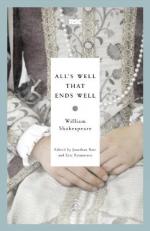|
This section contains 8,402 words (approx. 29 pages at 300 words per page) |

|
SOURCE: “Subjectivity, Desire, and Female Friendship in All's Well That Ends Well,” in Literature and Psychology, Vol. 32, No. 4, 1986, pp. 48-63.
In the following essay, Asp focuses on the reversal of power—inspired by Helena's desire—that allows Helena to succeed in her plans to win Bertram.
“That man should be at a woman's command and yet no hurt done!”
I.iii.92
According to prevailing opinion, All's Well That Ends Well is a “problem play” whose major difficulty is located in the very assertion that the title makes in summarizing the action. In the opinions of many critics the play does not “end well” because the resolution remains on the structural level rather than moving to the psychological level.1 The frog prince remains a frog until the end and the princess chooses to overlook his slimy skin. If the reader or theater-goer expects the romance of heterosexual coupling that...
|
This section contains 8,402 words (approx. 29 pages at 300 words per page) |

|


